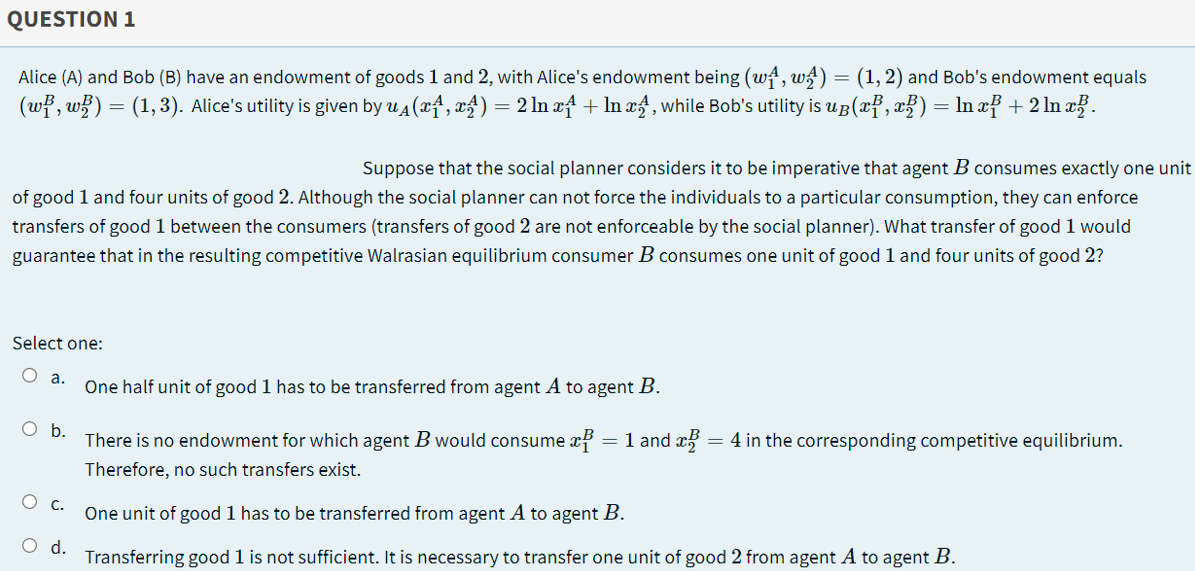Alice (A) and Bob (B) have an endowment of goods 1 and 2, with Alice's endowment being (wf, wg) = (1, 2) and Bob's endowment equals (wł, w}) = (1,3). Alice's utility is given by u4 (xf', xf) = 2 ln ¤f + In æg , while Bob's utility is uB(x?, x}) = ln ¤{ +2 ln ¤?. Suppose that the social planner considers it to be imperative that agent B consumes exactly one unit of good 1 and four units of good 2. Although the social planner can not force the individuals to a particular consumption, they can enforce transfers of good 1 between the consumers (transfers of good 2 are not enforceable by the social planner). What transfer of good 1 would guarantee that in the resulting competitive Walrasian equilibrium consumer B consumes one unit of good 1 and four units of good 2? Select one: O a. One half unit of good 1 has to be transferred from agent A to agent B. O . There is no endowment for which agent B would consume x = 1 and x = 4 in the corresponding competitive equilibrium. Therefore, no such transfers exist. O c. One unit of good 1 has to be transferred from agent A to agent B. Od. Transferring good 1 is not sufficient. It is necessary to transfer one unit of good 2 from agent A to agent B.
Alice (A) and Bob (B) have an endowment of goods 1 and 2, with Alice's endowment being (wf, wg) = (1, 2) and Bob's endowment equals (wł, w}) = (1,3). Alice's utility is given by u4 (xf', xf) = 2 ln ¤f + In æg , while Bob's utility is uB(x?, x}) = ln ¤{ +2 ln ¤?. Suppose that the social planner considers it to be imperative that agent B consumes exactly one unit of good 1 and four units of good 2. Although the social planner can not force the individuals to a particular consumption, they can enforce transfers of good 1 between the consumers (transfers of good 2 are not enforceable by the social planner). What transfer of good 1 would guarantee that in the resulting competitive Walrasian equilibrium consumer B consumes one unit of good 1 and four units of good 2? Select one: O a. One half unit of good 1 has to be transferred from agent A to agent B. O . There is no endowment for which agent B would consume x = 1 and x = 4 in the corresponding competitive equilibrium. Therefore, no such transfers exist. O c. One unit of good 1 has to be transferred from agent A to agent B. Od. Transferring good 1 is not sufficient. It is necessary to transfer one unit of good 2 from agent A to agent B.
Linear Algebra: A Modern Introduction
4th Edition
ISBN:9781285463247
Author:David Poole
Publisher:David Poole
Chapter2: Systems Of Linear Equations
Section2.4: Applications
Problem 27EQ
Related questions
Question

Transcribed Image Text:QUESTION 1
Alice (A) and Bob (B) have an endowment of goods 1 and 2, with Alice's endowment being (w4, ws) = (1, 2) and Bob's endowment equals
(wł, w}) = (1,3). Alice's utility is given by u4 (xf, xf) = 2 ln xf + In xf, while Bob's utility is uB(x}, x}) = ln xf +2 ln a.
Suppose that the social planner considers it to be imperative that agent B consumes exactly one unit
of good 1 and four units of good 2. Although the social planner can not force the individuals to a particular consumption, they can enforce
transfers of good 1 between the consumers (transfers of good 2 are not enforceable by the social planner). What transfer of good 1 would
guarantee that in the resulting competitive Walrasian equilibrium consumer B consumes one unit of good 1 and four units of good 2?
Select one:
O a.
One half unit of good 1 has to be transferred from agent A to agent B.
Ob.
There is no endowment for which agent B would consume xf = 1 and x
= 4 in the corresponding competitive equilibrium.
Therefore, no such transfers exist.
O C.
One unit of good 1 has to be transferred from agent A to agent B.
Od.
Transferring good 1 is not sufficient. It is necessary to transfer one unit of good 2 from agent A to agent B.
Expert Solution
This question has been solved!
Explore an expertly crafted, step-by-step solution for a thorough understanding of key concepts.
This is a popular solution!
Trending now
This is a popular solution!
Step by step
Solved in 2 steps with 1 images

Recommended textbooks for you

Linear Algebra: A Modern Introduction
Algebra
ISBN:
9781285463247
Author:
David Poole
Publisher:
Cengage Learning

Algebra & Trigonometry with Analytic Geometry
Algebra
ISBN:
9781133382119
Author:
Swokowski
Publisher:
Cengage

Trigonometry (MindTap Course List)
Trigonometry
ISBN:
9781337278461
Author:
Ron Larson
Publisher:
Cengage Learning

Linear Algebra: A Modern Introduction
Algebra
ISBN:
9781285463247
Author:
David Poole
Publisher:
Cengage Learning

Algebra & Trigonometry with Analytic Geometry
Algebra
ISBN:
9781133382119
Author:
Swokowski
Publisher:
Cengage

Trigonometry (MindTap Course List)
Trigonometry
ISBN:
9781337278461
Author:
Ron Larson
Publisher:
Cengage Learning